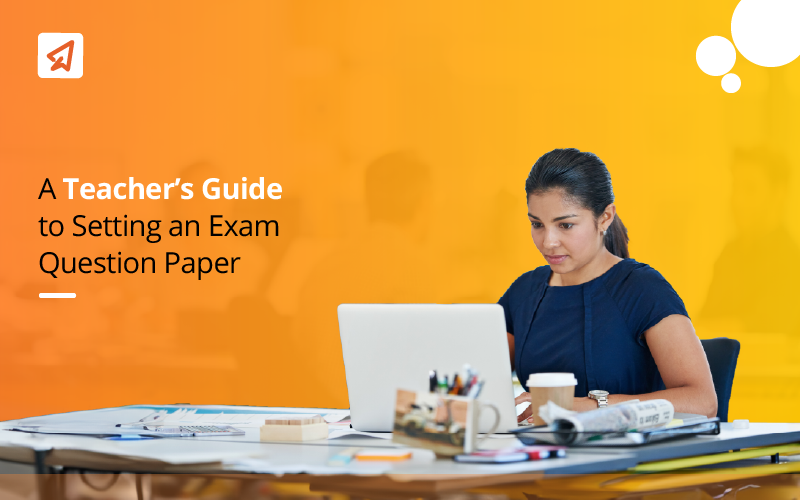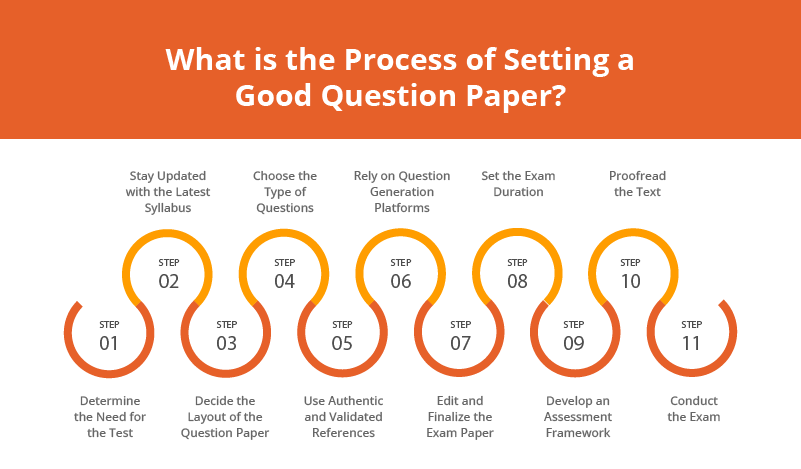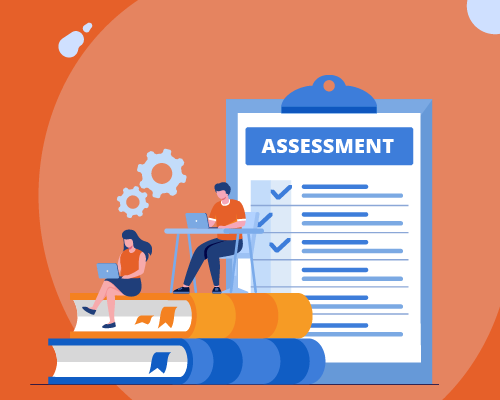A Teacher’s Guide to Setting an Exam Question Paper

Crafting a good question paper is like putting together a puzzle – you need the right pieces for it to work. It’s not just about testing if students remember specific facts; it’s about learning how well they connect the dots and think critically.
In this guide, we’ll explore valuable insights on how to set a question paper that not only assesses knowledge but also encourages critical thinking, making the process enjoyable for students.
What is the Process of Setting a Good Question Paper?

An exam paper should be set with the intent to enhance students’ learning outcomes by testing their knowledge effectively. A common mistake that some teachers make is that they set high-stakes question papers that greatly challenge students’ comprehension of topics. This could demotivate students and create undue academic pressure. What teachers should aim to do instead is design a versatile question paper that has a balance of both simple and complex topics, ensuring that when they set exam question papers, they consider the overall impact on students’ learning experience.
Let’s go through the process that can help you set a good question paper:
-
Determine the Need for the Test
Before diving into creating questions, it’s essential to establish the purpose of the test. What do you want to achieve? Make a list of aspects you wish to assess, ensuring a seamless alignment between the curriculum and the exam content. This step lays the foundation for a focused and effective question paper.
-
Stay Updated with the Latest Syllabus
Having the latest version of the syllabus is important. Familiarise yourself with the assessment criteria and select topics that are not only relevant but also add value to students’ lives. This ensures that the questions are in line with what students have been taught and are expected to know.
-
Decide the Layout of the Question Paper
Clarity is key when it comes to the layout of the question paper. Ensure that it is student-friendly, with clear instructions presented boldly. Provide enough space for written responses and maintain a consistent format. Question paper pattern should follow a logical sequence, and marks for each item should be clearly indicated, promoting transparency.
-
Choose the Type of Questions
The type of questions selected should align with the exam objectives. Whether multiple-choice questions (MCQs) for quick assessments or descriptive questions for in-depth understanding, the choice depends on what you want to evaluate. Consider the balance between different question types to assess a variety of skills.
-
Use Authentic and Validated References
Maintain the integrity of the exam by using authentic references that align with the material taught. Avoid using content from different sources, especially if students have been instructed and taught using certain specific materials.
-
Rely on Question Generation Platforms
Make use of technology to save time and resources. Question generation platforms can assist in creating exam papers efficiently. Retain control over the process and make necessary adjustments before finalising the paper. This step ensures a balance between technological convenience and maintaining the intended exam rigour. Transform test creation with Extramarks! Effortlessly craft papers in minutes using pre-designed templates. Access millions of diverse questions across boards and subjects. Try Extramarks!
-
Edit and Finalize the Exam Paper
Editing is a critical step in the question paper creation process. Collaborate with another teacher to review the paper for clarity, conciseness, and impartiality. Whether traditional or technology-driven, a thorough edit ensures the elimination of errors. Most question generator tools allow automatic editing of generated questions, providing an additional layer of refinement.
-
Set the Exam Duration
Determining the exam duration requires careful consideration. Understand the number and complexity of questions and the time required for each when you set exam paper. While exams assess the ability to perform within time constraints, it’s crucial to strike a balance to prevent undue stress. Conducting a trial exam, perhaps with another teacher, can help in setting a reasonable and effective exam duration.
-
Develop an Assessment Framework
An effective assessment framework is based on the objective of the test and details the learning outcomes, specific competencies, content domains and skills that need to be assessed.
Step 1: Design A Blueprint
Based on the assessment framework, teachers should create a blueprint that details all the content domains to be tested, question formats and types – including Multiple-Choice Questions (MCQs), short answers, etc., the total length of the test, and an aggregate percentage of different content areas within the test, ensuring adherence to the exam paper format.
Step 2: Choose An Effective Test Format and Scoring Guides
Broadly, the types of exam questions are either selected-response questions such as true or false, MCQs, etc., or constructed-response questions like long-essay type questions. The scoring guide must be aligned with the cognitive level of the questions.
Step 3: Conduct Tool Validation
Once the blueprint and test format are ready, teachers should follow this up by conducting a tool validation to examine the accuracy of the paper, check the alignment of questions, proofread for clarity of language, review scoring guides, etc. Classical Test Theory, Item Response Theory, Pilot Testing and Panelling are a few processes of tool validation.
-
Proofread the Text
Pass the finalised draft to an external reviser for a final proofread. Ensure all test items align with the syllabus, tasks are workable, and the paper can be completed within the set time. Incorporate suggested changes and conduct a final proofread before submission.
-
Conduct the Exam
The last step involves the actual administration of the exam, either online or offline, adhering to institutional guidelines. Utilise exam software for automation if available, streamlining the assessment process.
Types of Questions in an Exam Paper
Objective Questions
-
Multiple Choice
MCQs are among the most popular types of questions that have been used for many years across varied levels of examinations. They are composed of one question or a statement, also known as a stem, that has multiple possible answers, called choices. The stem can sometimes be a partial statement and will often have 3 to 5 choices, out of which one is correct, and the rest are alternatives or distractions.
Ideal for: These types of exam questions are best suited for clarifying key concepts and assessing students’ abilities to apply their understanding of topics effectively.
Bonus tip: Avoid using statements directly from the textbook. Instead, frame it in your own words to make the stem versatile. For choices, use at least 3 options that are based on common student misconceptions. This will help clarify concepts better. When dealing with multiple-choice questions, try to keep these things in mind when you create a question paper:
- Clear Question: Make sure the question is straightforward.
- Positive Wording: State things positively when you can, but if you have to go negative, make it clear.
- Clear Correct Answer: The right answer should be obvious.
- Good Grammar: Keep the language consistent and easy to understand.
- Tricky Choices: The wrong answers should sound reasonable to someone who doesn’t know the material.
- No Clues: Don’t give away the answer in the way you phrase the choices.
- Mix It Up: Make sure the length of the answers doesn’t give away the right one.
- Smart Use of “All of the Above” or “None of the Above”: Only use these when they really fit.
-
True or False
True or false questions are those where a statement is presented, which in this case acts as the stem, and students are required to indicate whether it is true or false. A huge advantage for teachers here is that such questions are the easiest to review and score. Such questions can tend to be either too easy or too difficult in nature. However, this helps create a versatile question paper that effectively tests students of varying aptitudes.
Ideal for: They are great for testing a large amount of content and evaluating a student’s understanding of topics with two logical responses.
Bonus tip: Use simple and clear statements that reflect a single idea. This will keep confusion at bay and allow students to interpret the statement correctly. You may also ask students to correct false statements to enhance the effectiveness of these types of exam questions.
Keeping these true and false questions fair involves:
- Simple Statements: Keep the statements short and clear.
- Clear True or False: Make sure there’s no room for doubt on whether something is true or false.
- Avoid Double Negatives: Don’t make things more complicated with double negatives.
- No Clues: Like with multiple-choice, keep things clue-free.
- Balanced Mix: Have about the same number of true and false statements.
-
Completion
Sentence completion questions test students’ ability to apply knowledge. Educators can ensure effective construction by:
- Contextual Blanks: Pose questions containing blanks within a statement or paragraph, requiring students to fill them correctly.
- Understanding Over Recognition: Emphasise the need for students to find answers, moving beyond simple recognition.
- Knowledge Assessment: Suitable for testing knowledge levels, these questions go beyond mere recognition.
-
Matching
These are the most effective types of exam questions to test the relationship between objects. It is specifically useful in subjects that involve events, dates, names, and important places. It generally has two columns – one column is the stem, and the other has corresponding responses. Students need to go through the first column and find the correct response from the options in the second column.
Ideal for: They are an excellent option for data-rich content areas and help test students’ knowledge and comprehension levels.
Bonus tip: Include directions that clearly mention the basis for matching the stimuli with responses. Also, limit the number of matching items and keep it between 5 and 15 items to avoid confusion.
To make good matching questions, keep these points in mind:
- The things you’re matching should have something in common.
- Say how the matching works – can things be used more than once?
- Put all the matching stuff on the same page.
- Make the matches uneven by adjusting the lists.
-
Classification Questions
Classification questions assess cognitive skills in spotting the odd one out. These questions gauge students’ information processing, creative thinking, and evaluation skills. As an educator, you must group items based on common qualities, requiring students to identify the item that doesn’t fit.
Subjective Questions
-
Short Answers
Short answers generally require students to answer any given prompts in brief, limiting the length to a few words or sentences. The length of the answer can be based on the weightage of marks it carries. Such questions are easy to construct, faster to score, and allow teachers to cover a broader range of course content.
Ideal for: These questions are great for testing foundational knowledge of key concepts, facts, and terms.
Bonus tip: It is best to use a mix of formats to test student knowledge. An example of this could be mentioning the definition and asking students to provide the term or asking students to fill in the blanks with the missing term.
-
Essay or Descriptive
Essay-type questions are those that demand long-form, logical, and integrated answers, which can vary in length, ranging from a few paragraphs to a few pages. Teachers may choose to include several sub-questions based on the curriculum and nature of assessment. There can be two forms of responses – extended response and restricted response. The former is where students explain their understanding and demonstrate creativity with examples. Teachers can use this to test their ability to evaluate and synthesise problems. Restricted responses involve parameters of comparison and distinction. It demands students to build on their knowledge and understanding of topics. An example of this would be, ‘Plastic has become a considerable hazard in today’s environment. List out the ways in which it can harm us and how we should address its impact.
Ideal for: It is a great question type to measure cognitive processes, gain student opinions on key concepts, and test their ability to organise and apply their understanding of topics.
Bonus tip: Formulate the questions clearly and make them comprehensive rather than focused. Try to integrate problem-based questions to drive creativity and evaluate how well students can apply their understanding.
-
Definition Type Questions
Definition-type questions play an important role in assessing a student’s grasp of fundamental concepts. These questions aim to evaluate a student’s ability to provide a concise and accurate explanation of a specific term, concept, or idea. When crafting such questions, educators should use phrases like “Define,” “What is the meaning of,” or “Explain the term.” The aim is to get students to explain what they know in a simple and clear way.
Ideal for: Definition-type questions come in handy when you want to check if students really grasp the main concepts in different subjects. They’re an excellent tool for educators to measure how well students understand the basics of a particular topic.
Bonus tip: To deepen students’ understanding, encourage them to provide multiple valid definitions for the same term or concept. This approach challenges students to consider different perspectives and nuances, fostering a more profound grasp of the subject matter.
-
Opinion-Based Questions
Opinion-based questions invite students to express their views on a given topic, often requiring them to agree or disagree with a provided opinion. These questions are well-suited for courses or subjects that involve critical thinking, analysis, and debate. They are particularly valuable in fields where multiple viewpoints are valid, such as the social sciences, humanities, and philosophy.
Ideal for: Opinion-based questions are best used in courses that encourage critical thinking and analysis. They prompt students to explore and defend their opinions, contributing to a more nuanced understanding of complex issues.
Bonus tip: Encourage students to provide justified opinions by requiring them to support their views with evidence, reasoning, or examples. This approach not only enhances critical thinking but also promotes effective communication skills.
-
Scenario-Based Questions
Scenario-based questions present students with hypothetical situations or scenarios, challenging them to apply their knowledge, skills, and critical thinking to solve a problem or make a decision within a given context. These questions are designed to evaluate a student’s ability to analyse, synthesise, and apply what they’ve learned in a real-world or practical setting.
Ideal for: Scenario-based questions are effective in assessing a student’s application of knowledge to practical situations. They are well-suited for subjects where the ability to make informed decisions or solve problems is crucial.
Bonus tip: When crafting scenario-based questions, draw inspiration from real-life situations or current events related to the subject matter. This not only makes the scenarios more engaging but also enhances their relevance, motivating students to apply their knowledge with enthusiasm.
Getting Around the Difficulty Level of Question Paper
-
Syllabus Planning
First things first: You want your exams to match what you’ve been taught in class. So, it’s crucial to cover the entire syllabus in the question paper. But here’s the catch – you also don’t want to surprise students with things they haven’t learned. Striking a balance between covering everything and staying within the syllabus is key. This means careful planning to make sure your exams test what they’re supposed to.
-
Selection of Questions
Picking the right questions is like choosing the ingredients for a recipe. You want a mix of questions from practice tests, textbooks, and other materials. Importantly, you don’t want to repeat questions from last year’s question papers – that wouldn’t be fair to your students. By selecting fresh questions, we encourage students to think creatively and apply their knowledge in new ways.
-
Time Consideration for Students
You design the paper, but students are the ones who have to tackle it. They need time to think, write, and double-check their answers. It’s essential to be mindful of this when deciding how much time to give. After all, you want to create an environment where students can show what they know without feeling rushed.
5 Simple Tips to Keep Things Fair and Error-Free
-
Third-Party Review Committee
As mentioned earlier, to ensure your exams are top-notch, a third-party review can be a game-changer, especially in the area of paper setting. These individuals aren’t directly involved in setting the paper, so they offer a fresh perspective. Their unbiased views help catch any mistakes or problems we might have missed.
-
Two-Level Checking and Effective Moderation
Taking it up a notch, having another expert review after the third-party check strengthens the process. It ensures that suggested changes are incorporated smoothly. This two-level checking system makes the moderation process more robust, leaving less room for errors.
-
Creating a Pool of Questions
Instead of putting together a whole paper yourself, why not involve other teachers? By gathering questions from different teachers, you create a diverse pool. Then, you can select questions from this pool, making the process more collaborative and bringing in fresh ideas.
-
Using Open Educational Sources
Let’s not forget the wealth of information available online. Platforms like Google and UNESCO’s Open Educational Resources offer a treasure trove of material. You can use these sources to find new and relevant content, keeping our exams up-to-date and in tune with global education standards.
-
Considering Exam Scope and Societal Trends
Lastly, you should stay updated with what’s happening in the society. Our exams should reflect the current times and avoid topics that might be controversial or offensive. It’s all about being aware and steering clear of any unintended pitfalls.
How Extramarks Simplifies Test Paper Creation For Teachers
Extramarks’ Assessment Center is your reliable companion, making assessments a breeze! It’s super easy to use, with a friendly interface that lets you customise tests according to what you’ve taught. You can pick questions quickly from a question bank and tweak them to match different topics and student levels. The best part? You and your fellow teachers can team up in real-time, share feedback, and make assessments together.
No more grading headaches either – the tool even helps with that. And there are informative data features available, providing valuable insights into your students’ performance.
Extramarks makes setting the right question paper a breeze.
Learn MoreLast Updated on November 7, 2024
Reviewed by

Prachi Singh | VP - Academics
Prachi Singh is a highly accomplished educationist with over 16 years of experience in the EdTech industry. Currently, she plays a pivotal role at Extramarks, leading content strategy and curriculum development initiatives that shape the future of education...read more.











